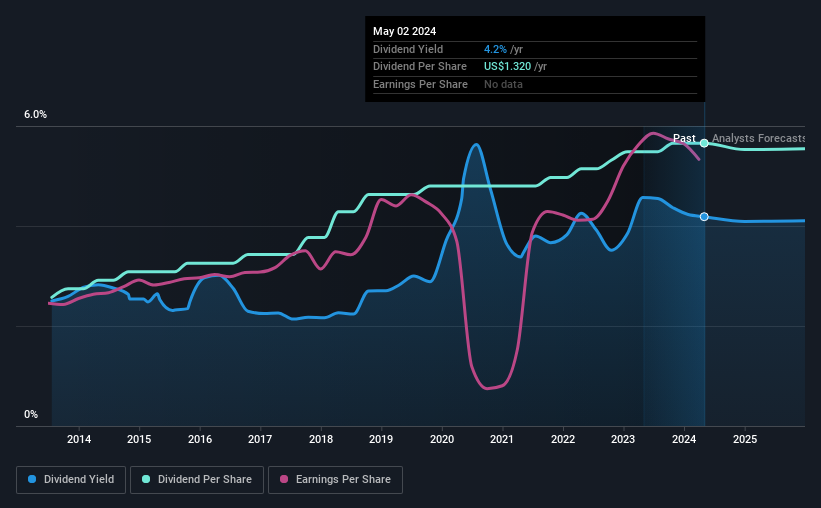Stock Analysis
- United States
- /
- Banks
- /
- NasdaqGS:STBA
Is It Smart To Buy S&T Bancorp, Inc. (NASDAQ:STBA) Before It Goes Ex-Dividend?

Some investors rely on dividends for growing their wealth, and if you're one of those dividend sleuths, you might be intrigued to know that S&T Bancorp, Inc. (NASDAQ:STBA) is about to go ex-dividend in just four days. The ex-dividend date is usually set to be one business day before the record date which is the cut-off date on which you must be present on the company's books as a shareholder in order to receive the dividend. It is important to be aware of the ex-dividend date because any trade on the stock needs to have been settled on or before the record date. This means that investors who purchase S&T Bancorp's shares on or after the 8th of May will not receive the dividend, which will be paid on the 23rd of May.
The company's next dividend payment will be US$0.33 per share, and in the last 12 months, the company paid a total of US$1.32 per share. Based on the last year's worth of payments, S&T Bancorp stock has a trailing yield of around 4.2% on the current share price of US$31.53. We love seeing companies pay a dividend, but it's also important to be sure that laying the golden eggs isn't going to kill our golden goose! As a result, readers should always check whether S&T Bancorp has been able to grow its dividends, or if the dividend might be cut.
See our latest analysis for S&T Bancorp
If a company pays out more in dividends than it earned, then the dividend might become unsustainable - hardly an ideal situation. That's why it's good to see S&T Bancorp paying out a modest 28% of its earnings.
Generally speaking, the lower a company's payout ratios, the more resilient its dividend usually is.
Click here to see the company's payout ratio, plus analyst estimates of its future dividends.

Have Earnings And Dividends Been Growing?
Stocks in companies that generate sustainable earnings growth often make the best dividend prospects, as it is easier to lift the dividend when earnings are rising. If business enters a downturn and the dividend is cut, the company could see its value fall precipitously. With that in mind, we're encouraged by the steady growth at S&T Bancorp, with earnings per share up 3.3% on average over the last five years.
Many investors will assess a company's dividend performance by evaluating how much the dividend payments have changed over time. Since the start of our data, 10 years ago, S&T Bancorp has lifted its dividend by approximately 8.2% a year on average. We're glad to see dividends rising alongside earnings over a number of years, which may be a sign the company intends to share the growth with shareholders.
The Bottom Line
Should investors buy S&T Bancorp for the upcoming dividend? S&T Bancorp has seen its earnings per share grow slowly in recent years, and the company reinvests more than half of its profits in the business, which generally bodes well for its future prospects. We think this is a pretty attractive combination, and would be interested in investigating S&T Bancorp more closely.
In light of that, while S&T Bancorp has an appealing dividend, it's worth knowing the risks involved with this stock. Our analysis shows 1 warning sign for S&T Bancorp and you should be aware of this before buying any shares.
Generally, we wouldn't recommend just buying the first dividend stock you see. Here's a curated list of interesting stocks that are strong dividend payers.
Valuation is complex, but we're helping make it simple.
Find out whether S&T Bancorp is potentially over or undervalued by checking out our comprehensive analysis, which includes fair value estimates, risks and warnings, dividends, insider transactions and financial health.
View the Free AnalysisHave feedback on this article? Concerned about the content? Get in touch with us directly. Alternatively, email editorial-team (at) simplywallst.com.
This article by Simply Wall St is general in nature. We provide commentary based on historical data and analyst forecasts only using an unbiased methodology and our articles are not intended to be financial advice. It does not constitute a recommendation to buy or sell any stock, and does not take account of your objectives, or your financial situation. We aim to bring you long-term focused analysis driven by fundamental data. Note that our analysis may not factor in the latest price-sensitive company announcements or qualitative material. Simply Wall St has no position in any stocks mentioned.
About NasdaqGS:STBA
S&T Bancorp
Operates as the bank holding company for S&T Bank that engages in the provision of retail and commercial banking products and services.
Flawless balance sheet, good value and pays a dividend.


